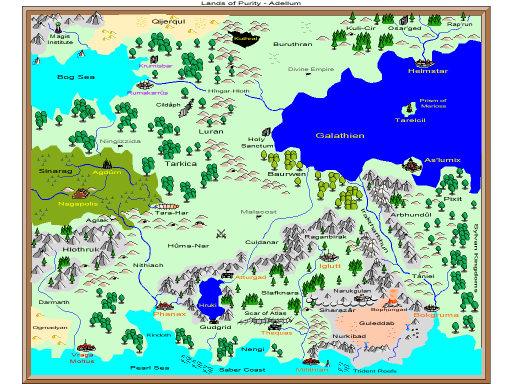| Category | Fallen Empires | ||||
| World | Bal-Kriav | ||||
| Region | Lands of Purity | ||||
| Government | Autocracy | ||||
| Capital | Vraga Moltus | ||||
| Population | |||||
| Races |
| ||||
| Deities | Athena, Atlas, Phalgas | ||||
| Enemies | Black Tide of Thasmudyan, Ba'lith, Garormuk, Targad | ||||
| Reign | 1017 - 1486 | ||||
| Map | Adellum |
In the Great Exodus (998 - 1017), a great migration of peoples left the stricken lands of Karterus for the Brucrmus mainland. Those that went to lands staked out in Brucrumus's far east, a 2300 mile ocean voyage, settled in the Adellum Sector. Most of these people were refugees of the Niratar Theocracy, a nation on its last legs. Crossing uncharted waters, overcrowded ships, pirates increasing by the day, the movement of ships over a vast area led to many losses. One of the most damaging for Niratar was when nearly half of Niratar's leadership, high priests of Athena, Arcana and Kebechet, were murdered in the waters and on the fog enshrouded shores of Masked Landing. This organized attack was a hit by twelve ships with holds full of sociopath assassins and loot hungry pirates, all paid for by Demogorgon's cultists. The reason for this attack was revenge against the goddess Athena, a Covenant commander who caused Demogorgon trouble in the Demon Spawn War.
Those that made it to Adellum, concentrated on the coasts at Vraga Moltus. Built in 1015, this storied city became Niratar's new capital. Two years later, after much deliberation, the people voted for a change in government. They chose an autocracy, replacing Niratar's centuries old theocracy. This change in public opinion was blamed on the Great Exodus and the general belief that the gods didn't do much to help them in their greatest time of need. The Farinteen family was chosen to lead the people. The Fartineens, descendants of Lagad-Bast, a Krotoan sub-commander under Lukoon in the Demon Spawn War, replaced the theocracy with what would become a equally long hereditary rule.
Farinteen society was built on strong laws and equality of races. A product of the Niratar Theocracy that preceded it, it had a religious fervor that steadily grew with the conflicts that followed the Tragaran push into new lands.
The Farinteens aggressively expanded their frontiers with the goal of bringing civilization and religion to Phiyel's interior. Phiyel, a large region, under the Farinteen's became better known as the Lands of Purity. The leading churches were those of Athena, Atlas and Phalgas. The backbone of the empire's army were the Lances of Merioss.
Late in the 1060s, Farinteen's northern expansion, settlements, mining claims, and strategic interests, led to conflict with Sinarag's natives. These were yuan-ti, Lorhazi, greenies and Graagvrii; generally supported openly or secretly by the Nagapolis city-state. Problems with Sinarg's inhabitants led to a chain of towers, forts and imposing castles from the Aglak Rampart to the bowels of Tara-Har. While the empire battled with yuan-ti slavers and agents of Nagapolis, another conflict started north of Vraga Moltus. In this area, goblins and Zog-Nee barbarians debauched from the Hlothruk Mountains, plundering and pillaging Farinteen frontier settlements.
Expansion westward past the Culdanar River and along the banks of the Galathien proved more peaceful, with friendly relations established with the locals, Forstneblin, wood elves, and dwarves. Farinteen attempts to spread their religion into these areas brought conflicts. These were minor affairs, eventually leading to the Articles of the Four Peoples. These laws and guidelines for peace and prosperity covered religion tolerance, letting the people decide, and other concerns like freedom of movement, banking, and trade. These Articles would become the foundation for Fartineen's successor, the country of Malacost. In addition to the local of the Lands of Purity, Farinteen maintained strong trade and a mutual defense pacts with the people of Ivory Asylum.
In the Black Tide War (1465 - 1486), the undead armies of the Black Tide of Thasmudyan pushed west from Hells Womb into the Lands of Purity. The Farinteen Alliance were slowly driven back. General Garn, a leader of the Black Tide, secured Ebonstar, sending armies into Hlophar-Maur. Another lich leader, Katrana Dumu-loc went south across Galathien, wrecking havoc in the Sylvan Kingdoms. By sea, Admiral Jariall raided the empire's coastal holds. Pinth, backed by dwarven mercenaries out of Naram-Gunal supported Garn's push. The Hlophar-Maur Breakout was followed by many more battles, legendary ones like the Luran Campaign and the Siege of Vraga Moltus. In 1486, Vraga Moltus was captured, ending Farinteen rule. Those fortunate enough to escape went east into the Raganbirak highlands, battling Targad for a place to live, and rebuild their forces.
Following the fall of the Black Tide in the Athenian Crusade (1539 - 1551) and in the Artery War (1546 - 1554), many former Farinteens became citizens of the Country of Malacost.
